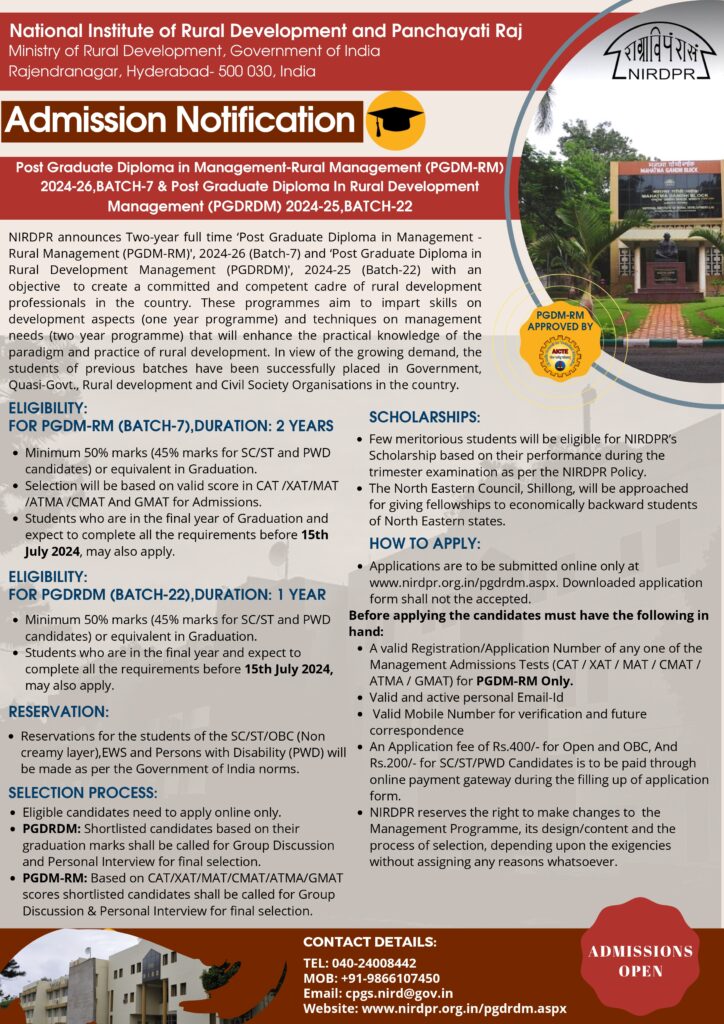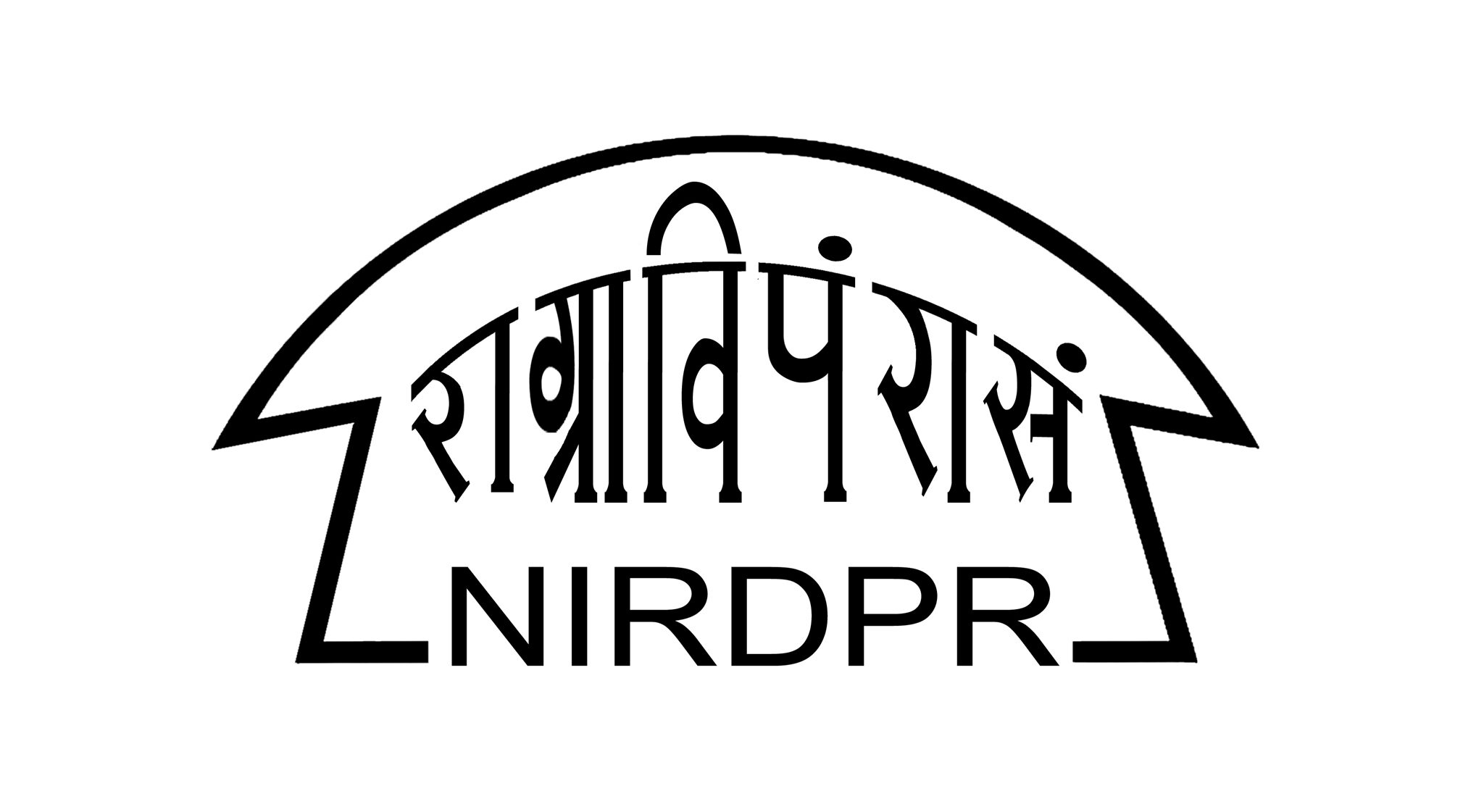
CONTENTS:
LEAD STORY: NRLM’s Contribution to Women’s Livelihoods and Inclusive Economic Development in India
Project for Creating Model GP Clusters Bringing Noticeable Changes – Case Study from Gurumitkal Cluster of Karnataka
International Scoping Workshop on Artificial Intelligence in Rural Development and Panchayati Raj
Training Programme on Mission LiFE and its Implementation for Rural Development
Induction Level Orientation of Young Fellows Batch-2 on the Project for Creating Model GP Clusters
LEAD STORY:
NRLM’s Contribution to Women’s Livelihoods and Inclusive Economic Development in India
Dr Vanishree J.
Assistant Professor, Centre for Gender Studies and Development, NIRDPR
vanishreej.nird@gov.in
The National Rural Livelihoods Mission (NRLM), a flagship initiative by the Indian government, is strategically designed to improve rural livelihoods and alleviate poverty. Central to its approach is the establishment of a network of community institutions that mentor and support women self-help groups (SHGs), connecting these to village organisations (VOs) and cluster-level federations (CLFs). This article explores the multifaceted impacts of NRLM, with a primary focus on analysing how the programme enhances livelihoods and contributes to the process of women’s empowerment. Through a comprehensive analysis derived from Randomised Controlled Trials (RCTs), Quasi-Experimental, and Qualitative Studies, the author aims to provide an understanding of NRLM’s role in empowering women and transforming the rural economy.

The expected outcomes from NRLM are multi-layered, targeting income generation, female ownership of assets and land, microenterprise setup, increased participation in paid employment, and control over financial decision-making by women. However, the impact of such interventions, as derived from Randomised Controlled Trials (RCTs), Quasi-Experimental, and Qualitative Studies, presents a complex picture. While some studies suggest a moderately positive but not transformative impact of microfinance access, others find positive impacts on productive assets, though not universally. Access to microcredit or savings does not consistently increase women’s income. Still, older SHGs lead to a significant rise in the total income of the household, primarily through enhanced earnings in wage labour markets and the Mahatma Gandhi National Rural Employment Guarantee Scheme (MGNREGS).
The significant contribution of the programme is the decline in informal loans which has positive impacts on household productive assets and expenditure on education and food. However, it appears to have no impact on women’s decision-making within households, nor does it consistently improve women’s household decision-making power. Restrictive social norms and household dynamics often limit women’s ability to use financial capital to transform their businesses. As the programme matures, implementation delays, monitoring gaps, and low levels of livelihood and income-generating activities at the start are being addressed and alleviated. Yet, the existing Panchsutra standards set for SHGs are extremely high and difficult for most to achieve, suggesting a need for more realistic standards.
Many studies have explored how features that give women control over the receipt of funds, like direct deposits or mobile money, may offer more flexibility in accessing and using resources. This requires infrastructure for digital transfers and tries to work around restrictive gender norms. While financial inclusion policies targeting women produce different results than those targeting households, they are effective only if they provide women with access to relatively large loans.

A positive correlation is observed between the concentration of SHG membership in a district and female labour force participation (LFP), with an increase in SHG numbers linked to more female labour force participation. A compelling need persists to enhance rural non-farm employment, as the substantial growth in India’s working-age population surpasses available job opportunities, particularly for women burdened with domestic chores and caregiving responsibilities. Increasing India’s Female Labor Force Participation (FLFP) to meet international standards necessitates efforts beyond merely increasing SHG enrollment.
Over the last decade, while 27 million women transitioned from farm to non-farm sectors, a significant decline in agricultural jobs has not been offset by alternative employment, leading to 5 million additional women joining the non-farm sector and others withdrawing from the labour force. The reasons behind this shift are multifaceted, encompassing safety concerns, job immobility, lack of skills, increased educational opportunities, and relative male earning potential.
Despite these challenges, studies have revealed that a 10 per cent increase in education correlates with an 18 per cent rise in female entrepreneurship, demonstrating the profound influence of educational attainment on women’s economic agency. More than 90 per cent of household enterprises are self-financed, indicating an unmet demand for credit amounting to a staggering US$ 520 billion. This financial gap signifies a substantial barrier to women’s business ownership and enterprise growth, which is notably correlated with increased labour participation among women.
The social capital generated by the programme is argued to have a significant positive impact, even though the primary focus is on enhancing livelihoods. This social capital contributes to the strengthening of the process of women’s empowerment, highlighting the programme’s broader implications beyond economic metrics. In conclusion, while NRLM has made advances in empowering rural women and enhancing livelihoods, a deep understanding of its impact and adaptations for its strategies is crucial for realising its full potential in driving inclusive economic growth and women’s empowerment in rural India.
Project for Creating Model GP Clusters Bringing Noticeable Changes – Case Study from Gurumitkal Cluster of Karnataka
Dipti Paridhi Kindo
Senior Consultant (Research & Documentation), CPRDP&SSD, NIRDPR
dipti.paridhi@gmail.com
Background
In 2021, NIRDPR launched the Project for Creating 250 Model Gram Panchayat Clusters (PCMGPC), supported by the Ministry of Panchayati Raj (MoPR). The Project Management Unit (PMU), established at Centre for Panchayati Raj, Decentralised Planning and Social Service Delivery (CPRDP&SSD), NIRDPR, is coordinating this project with the support of State Programme Coordinators (SPCs) and Young Fellows (YFs). The YFs provide technical guidance and handholding support to achieve holistic and sustainable development through institutional strengthening of Gram Panchayats (GPs) nationwide and enablement of SDG-focused theme-based Gram Panchayat Development Plans (GPDP). This article describes how the combined efforts of GP officials and the endeavours of a Young Fellow brought in noteworthy changes in a Gram Panchayat.
A Young Fellow, Shri Gugulothu Saikumar, has been deployed in the Gurumitkal Cluster of Yadgir district in Karnataka since October 2021. Since his posting, he has worked dedicatedly to bring remarkable changes by providing handholding support through his positive interventions with different stakeholders and elected representatives. The Putpak and Chandraki Gram Panchayats, with Ms Ramlingamma and Ms Devamma as respective GP Presidents, have pledged for Theme 3: Child-Friendly Village as one of the Sankalp in the FY 2023-2024 and have been working towards the achievement of its vision to “ensure that all children can enjoy their rights to reach their full potential.” Subsequent to his dedicated engagement with all stakeholders, the YF could draw up a constructive strategy to uplift education within the GP clusters. After recognising education as the cornerstone of development, the focus was extended from Anganwadi Centres (AWCs) to high schools. With constant support and direction from the Project Monitoring Unit, Shri Gugulothu Saikumar has demonstrated exemplary work.
Key Achievements
Shri Gugulothu Saikumar organised four Bal Sabhas to promote child sensitivity and youth empowerment. Under his initiative, water tanks were installed at Keshwar Upper Primary School and Chandraki Primary School. Two mini reverse osmosis machines were installed in schools and AWCs, and two more have been planned. A borewell was constructed in Government Higher Primary School, Mallapur and four toilets, and new compound walls were built in Keshwar and Chandraki schools besides the construction of a gate and dining hall at Putpak High School. He played a vital part in the renovation of four AWCs and in ensuring water pipeline connections at Chandraki Primary School. Quality, nutritious and timely meals were provided at all AWCs and schools, and a basketball court was established at the high school. Shri Gugulothu Saikumar organises legal awareness programmes for children and STEM science fair facilitation and career guidance programmes at regular intervals. This apart, he was instrumental in establishing libraries in three schools.

The Young Fellow also came to the rescue of youth in the GP, who were finding it difficult to buy study materials for competitive exams. Following the intervention of Shri Gugulothu Saikumar, the elected members provided Rs. 35,000 to youth for purchasing the books of their own choice for the exams, eventually establishing an exclusive library for the competitive examinations. Besides organising preventive healthcare check-ups in association with the Rashtriya Bal Swasth Karyakram (RBSK) team at the primary school in Keshwar village of Chandraki GP, the YF has also delivered an awareness session on the importance of health and hygiene.
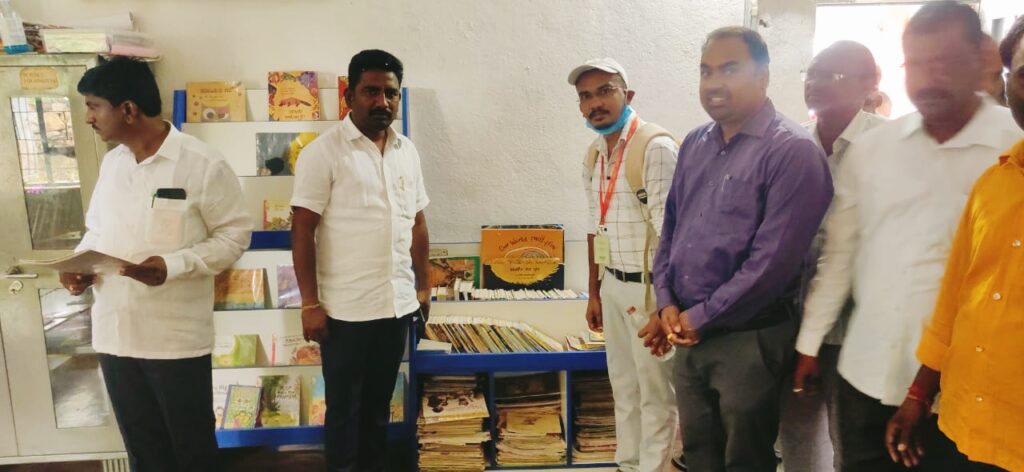
The GP community is continuously working on inculcating and improving daily reading habits among local schoolchildren. Digital teaching platforms and basic teaching modules are also used as teaching tools. Three awareness sessions on filariasis have also been conducted in schools.

In the academic year 2021-22, Bhagyamma, the daughter of a villager Malappa, secured the district’s second position in the final tenth-class exams. This was a tremendous boost for the students and Putpak GP. Sports and cultural events and academic sessions are also widely encouraged in this high school; Putpak GP also appreciates the efforts of school students. On 18th June 2022, Ms Snehal, IAS, District Collector, appreciated the efforts of the Gram Panchayat while attending a grievance redressal meeting organised at the high school. Mallapur Upper Middle School has been selected to be developed as a model school. In this regard, the GP has invested Rs.80,000 in a special OSR fund to create and install a new borewell with an electrical motor. Saplings were also planted on the school compound, and separate toilet compound walls were also constructed. Activities like roof cementing (renovation) work have also been planned for the school.
Challenges Faced
In the early days, lack of awareness was prevalent, and innovative approaches were unacceptable. The generation-driven illiteracy and backwardness due to migration was found to be affecting the children’s education.
Approach Taken
A patient-positive approach was adopted in the initial days, and motivation was given through live examples and showing other best practices. The Panchayat Bandhu team helped in creating awareness and bringing constructive changes.
Support Received
The dedication of the Young Fellow was appreciated, and he received support from all elected representative members and GP officials.
Appreciating the project initiatives of NIRDPR and MoPR, Mr. Eerappa, Panchayat Secretary, said that they were thankful to the Young Fellow who strived hard to make it a model GP. “The Young Fellow is guiding us on technical aspects of the Panchayat matters, and his efforts are praiseworthy. His support towards our GP’s development is phenomenal. He is continuously guiding and mentoring our GP, especially in matters of service delivery for the community and children,” he adds.

Roadmap for Sustainability
Efforts to promote literacy were extended to the creation of a conducive reading environment whereas measures have been taken to maintain the present status of zero dropout rates across all schools. In this regard, ERs, GP officials, Panchayat Bandhus, and Gram Panchayat Planning Facilitation Team members make regular visits to schools. Thus, with the collaborations and joint efforts of all the stakeholders, a positive environment has been built in the GP to achieve better outcomes in the future. The Gram Panchayat officials supporting this project are continuously working to make it a child-friendly GP for its saturation as a “Shiksha Yukt Panchayat.”
What They Said
With the support of Young Fellow, our school has developed a lot. The water from the newly drilled borewell is used for drinking, cooking purposes, toilet use, and gardening. Our school has been selected to be developed as a model school in the district. In this direction, the Young Fellow, teachers, ERs, and community members are working to develop GP with an overall integrated approach.
Shri Narsappa, Head Master, Government Higher Primary School, Mallapur (Putpak GP)
We are thankful to NIRDPR and MoPR for this PCMGPC initiative, which has resulted in the development of GP in the form of installation of water connections, construction of borewells and toilets in schools, promoting the idea of dustbins distribution, resolving drainage problems, etc. The Young Fellow guides the community in the planning and execution processes, and he explains matters in detail by offering practical solutions.
Shri Venaktappa, Beneficiary, Mallapur (Putpak GP)
(The author sincerely thanks Dr Anjan Kumar Bhanja, Associate Professor and Head, CPRDP&SSD, for the initial discussion and suggestions on an earlier draft of this note.)
International Scoping Workshop on Artificial Intelligence in Rural Development and Panchayati Raj
The National Institute of Rural Development and Panchayati Raj (NIRDPR) hosted a dynamic two-day International Scoping Workshop on AI in Rural Development and Panchayati Raj (RD&PR) from 21st – 22nd March 2024, on its Hyderabad campus.

The workshop served as a platform to initiate the establishment of an Artificial Intelligence research lab dedicated to Rural Development and Panchayati Raj. This collaborative effort aimed to engage stakeholders and concentrate on various thematic areas within RD&PR programmes, fostering sustainable development.
Featuring keynote sessions and panel discussions, the workshop delved into pivotal thematic areas, including AI applications in agriculture, rural development, healthcare, primary education, scheme implementation, audit processes, and finance in rural areas.
Renowned national and international experts, including academics, researchers, industry professionals, and policy experts from the USA, Belgium and India, shared their insights and expertise during the event. Their contributions will shape recommendations for the development of the Center of Excellence for AI in RD&PR.
Additionally, the workshop witnessed the active participation of approximately 30 academic experts from various universities, colleges, faculty, and student communities, enriching discussions alongside the expert panels.
Dr G. Narendra Kumar, IAS, Director General, NIRDPR, inaugurated the workshop. In his address, he underscored the pivotal role of AI in RD&PR to enhance operational efficiency, effectiveness, and accountability, ultimately leading to improved service delivery and increased public trust.

Dr Chandra Shekar Kumar, IAS, Additional Secretary, Ministry of Panchayati Raj, spoke about the importance of AI in Panchayat Raj Systems. Shri Prakash Kumar, IAS (Retd), CEO of Wadhwani Centre for Government Digital Transformation, Dr E. G. Rajan, Chairman of Pentagram Group of Companies, Prof. K. S. Rajan, Registrar of IIIT Hyderabad and Prof. Ravindra S. Gavali of NIRDPR demonstrated various tools & models and highlighted the need of AI in RD&PR. The workshop was coordinated by Dr M. V. Ravibabu, Associate Professor & Head, Centre for Information Communication & Technology, NIRDPR.
Training Programme on Mission LiFE and its Implementation for Rural Development
Mission LiFE (Lifestyle for Environment) emerges as a crucial global initiative in the fight against climate change, originating from India’s leadership at COP26. This movement stands out for its democratic and inclusive approach, connecting individuals and communities in the collective endeavour to protect and preserve the environment. By promoting a lifestyle in harmony with nature, Mission LiFE inspires positive behavioural changes that contribute significantly to addressing the challenges of climate change. The mission acknowledges the inherently sustainable aspects of Indian culture and living traditions, emphasising the importance of conserving natural resources. With a goal to mobilise a billion individuals globally, Mission LiFE seeks to create a widespread, positive impact by fostering a collective effort towards a sustainable and environmentally conscious way of life. In the context of rural development, ‘Mission LiFE (Lifestyle for Environment)’ can act as a catalyst for meaningful transformation. In rural landscapes, the emphasis is on promoting practices that align with the natural rhythm of life. Encouraging conservation and sustainable activities becomes a cornerstone, empowering communities to prosper while safeguarding their natural resources. In this journey, Mission LiFE becomes a guiding force, advocating for positive changes that ripple through rural communities, shaping a sustainable future where each village stands as a testament to the transformative power of collective action. Considering the significance of Mission LiFE in the rural development context, the Centre for Natural Resource Management, Climate Change and Disaster Mitigation (CNRM, CC&DM), NIRDPR organised a three-day National Level Training Programme from 18th to 20th March 2024 on its main campus in Hyderabad. A total of 36 participants attended and were certified in the training programme.

The objectives of the training programme were to (i) equip participants with skills to integrate Mission LiFE principles into rural development practices, (ii) empower diverse stakeholders to act as agents of positive change in rural areas through Mission LiFE programme, and (iii) share Knowledge and best practices for sustainable rural development through Mission LiFE.
The training programme commenced with a welcoming address by Dr Ravindra S. Gavali, Professor & Head at CNRM, CC & DM, NIRDPR, Hyderabad. In his inaugural address, Dr Gavali conveyed the objectives of the programme and underscored the significance of Mission LiFE for rural development. Further, the participants took the Mission LiFE Pledge, demonstrating their commitment to sustainable living and environmental responsibility.
In the opening session, Dr. Ravindra S Gavali, Head of CNRM, CC&DM, NIRD, delivered a comprehensive lecture on the ‘LiFE’ mission and its pivotal role in rural development. He emphasised the significance of adopting a sustainable lifestyle rooted in conservation and moderation to combat climate change effectively. Dr. Gavali explained how the ‘LiFE’ campaign serves as a catalyst for promoting environmental consciousness on a mass scale.

Dr Sudesh Yadav, Professor, JNU, New Delhi, delivered an insightful guest lecture on sustainability and the ‘LiFE’. In his address, he emphasised the importance of adopting sustainable practices besides delving into practical solutions for waste management at both village and individual levels. He elaborated on the transition from the 3R to 5R and 5R to 7R approach. Stressing the significance of 7R approach (Rethink, Refuse, Reduce, Repurpose, Reuse, Recycle and Rot). He also shed light on techniques such as composting and rainwater harvesting as integral components of sustainable living. Furthermore, Dr Yadav highlighted the value of traditional practices in achieving sustainable development, sparking discussions on their integration into modern approaches.
Dr. Sarbindu Bhaduri, Professor, JNU, New Delhi, led a session titled ‘Frugal Innovation for Mission LiFE in Rural India: Chalking out a Roadmap.’ During his presentation, Dr. Bhaduri outlined strategies for fostering innovation in the context of Mission LiFE, focusing on rural India. He discussed the basic concept of frugal innovations and how it is important for attaining a sustainable lifestyle by lowering our carbon and ecological footprints. He emphasised the importance of creating a roadmap that incorporates frugal and innovative solutions to address environmental challenges and promote sustainable living practices. Dr Bhaduri encouraged collaboration between academia, government agencies, and local communities to drive impactful innovation initiatives.
Dr Bharatha Vinaykumar, Research Manager, Nutrihub, ICAR-Indian Institute of Millets Research, conducted a session on ‘Adapting Sustainable Food Systems (Millets) to Tackle Future Food Crises.’ Throughout his lecture, he elaborated on various aspects of sustainable food systems (SFS), emphasising the significance of millets. Dr Vinaykumar discussed the rationale behind incorporating millets into food systems, both in India and globally, highlighting their environmental sustainability, water conservation benefits, and contributions to biodiversity. He also delved into the role of millets in ensuring food security, traced major production trends in India, and stressed the importance of research and development in millet processing and value addition.
Dr B. Ganesh Kumar, Principal Scientist & Head, ICAR-NAARM, conducted a session on ‘Climate Resilient Interventions through Livestock & Poultry Farming.’ Throughout his lecture, he emphasized the significance of the livestock sector, detailing India’s global share and the features of livestock production systems. Dr Kumar elucidated the intricate relationship between climate change and livestock, discussing aspects such as feed intake, nutrient utilization, animal production, reproduction, and the impact of climate change on infectious diseases. He also addressed the influence of veterinary medicine residues on the food chain and environment, alongside global greenhouse gas emissions by livestock species.
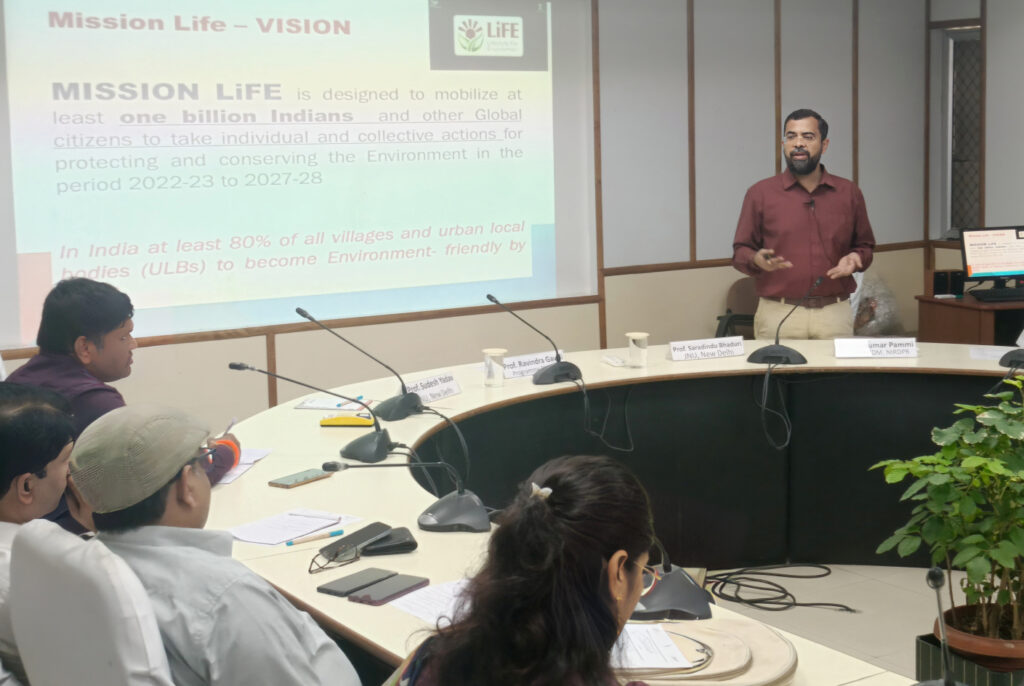
During the visit to NIRDPR’s Rural Technology Park, guided by M.D. Khan, Senior Consultant, NIRDPR, practical aspects of training, extension, and technology transfer in rural areas were explored. The focus was on hands-on training for rural communities, showcasing tailored innovations in agriculture, water management, and renewable energy solutions. Emphasis was placed on the crucial role of extension services in disseminating knowledge to farmers and villagers, bridging the gap between research institutions and rural communities. The visit provided valuable insights into empowering rural areas through sustainable practices, fostering self-sufficiency, and overall development, highlighting the significance of training, extension, and technology transfer in enhancing livelihoods and building resilient rural communities.
In his session on ‘Integration of Flagship Programmes with Mission LiFE in Rural Development,’ Dr Raj Kumar Pammi, Assistant Professor at CNRM, CC&DM, NIRDPR, provided comprehensive insights into the importance of integration and outlined various key initiatives. He highlighted the convergence of MGNREGA, Focused Action Plan, and the roles of Gram Panchayats in implementing Mission LiFE. Additionally, Dr Pammi discussed the significance of integrating programs like NRLM, PMKSY, Finance Commission Grants, and Sansad Adarsh Gram Yojana. He emphasized promoting household engagement in the principles of reduction, reuse, and recycling, suggesting the involvement of urban local bodies and resident welfare associations in creating dedicated centres for sustainable practices. Moreover, participatory tasks were assigned to participants, encouraging them to brainstorm integration strategies for Mission LiFE with rural development programs.
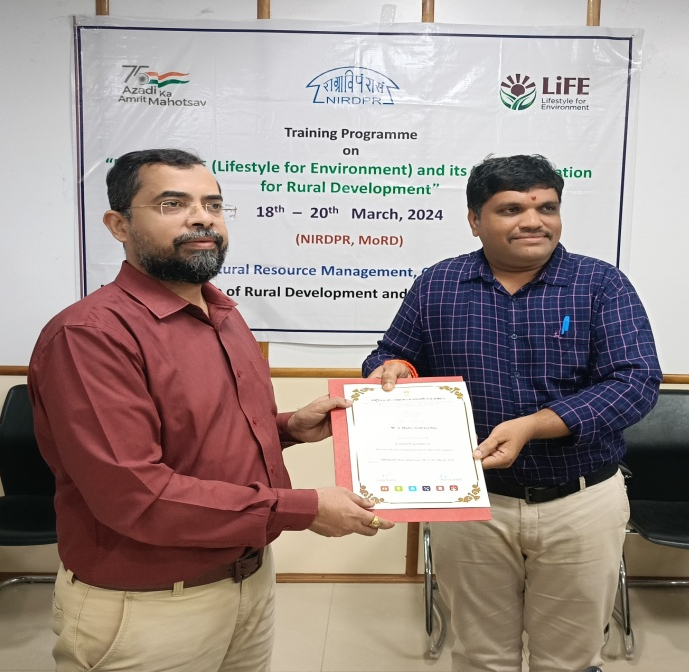
Dr Jyothis Sathyapalan, Professor at CNRM, CC&DM, took a session on ‘Green and Climate Resilient Infrastructure for Rural Development.’ Throughout his lecture, he provided a comprehensive overview of the importance of developing environmentally sustainable and climate-resilient infrastructure in rural areas. Dr Jyothis discussed strategies for integrating green practices into infrastructure projects, emphasising the utilisation of renewable energy sources, eco-friendly construction materials, and nature-based solutions such as green roofs, permeable pavements, and rain gardens. He underscored how green infrastructure not only mitigates environmental impacts but also enhances community resilience to climate change while promoting biodiversity and ecosystem health.
The training program ended with a valedictory address, evaluations, and feedback. Dr. Ravindra S. Gavali, Professor and Head of CNRM, CC&DM led the session. Dr. Gavali conveyed sincere appreciation for the active participation and enthusiasm shown by participants, acknowledging their dedication and contributions to the program’s success. Dr. Gavali also shared his views during the session, praising participants for their active involvement and commitment throughout the program.
Feedback from participants was collected, with evaluations reflecting an overall programme effectiveness rating of 92 per cent. The training programme’s interactive and participatory nature proved immensely beneficial, as confirmed by participants’ feedback.
Induction Level Orientation of Young Fellows Batch-2 on the Project for Creating Model GP Clusters
The Centre for Panchayati Raj, Decentralised Planning, and Social Service Delivery (CPRDP&SSD), NIRDPR conducted a ten-day Induction Level Orientation for newly engaged Young Fellows (YFs) of Project for Creating Model GP Clusters (PCMGPCs) – Batch 2 from 12th to 22nd February 2024.
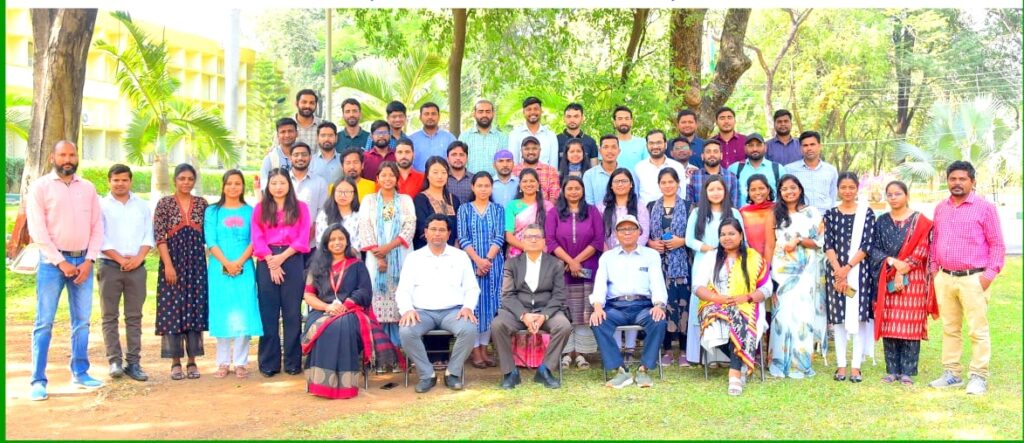
Dr Chandra Shekhar Kumar, IAS, Additional Secretary, Ministry of Panchayati Raj, delivered a special address outlining the Ministry programmes, achievements and various portals of the MoPR. He emphasised improving the roles of YFs. The primary objective of the PCMGPCs was to establish demonstrable models of Gram Panchayats (GPs) using a Cluster approach to accomplish comprehensive and sustainable development. This involves (a) strengthening the institutions of GPs and (b) facilitating LSDG-focused Theme-based Quality GPDP by offering mentoring, motivation, additional technical guidance, and professional support through qualified and thoroughly trained YFs to encourage other GPs to emulate the Project GPs as models. On 25th January 2024, 170 candidates were selected through a competitive process and were engaged as YFs. Forty-one participants posted in different clusters of 24 States attended batch 2 of the training programme.
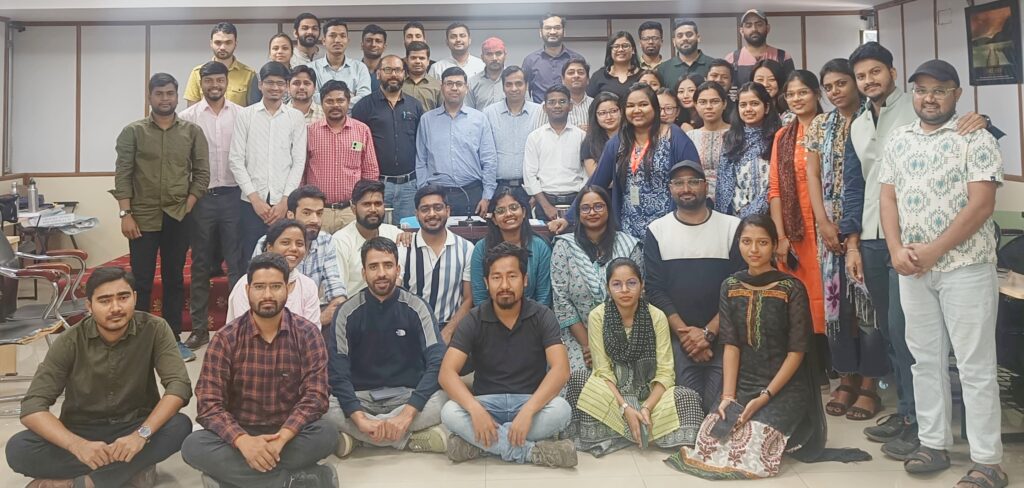
Shri S. M. Vijayanand, IAS (Retd.) Former Director General of NIRDPR and Former Secretary of MoPR led sessions discussing the significance of Gram Panchayats in rural transformation, SDGs and GPDP, the roles of SHGs and other support institutions, including academic institutions and UBA, overcoming challenges to achieve project outcomes, the roles of YFs, and fostering an attitudinal shift towards a mission-oriented approach.
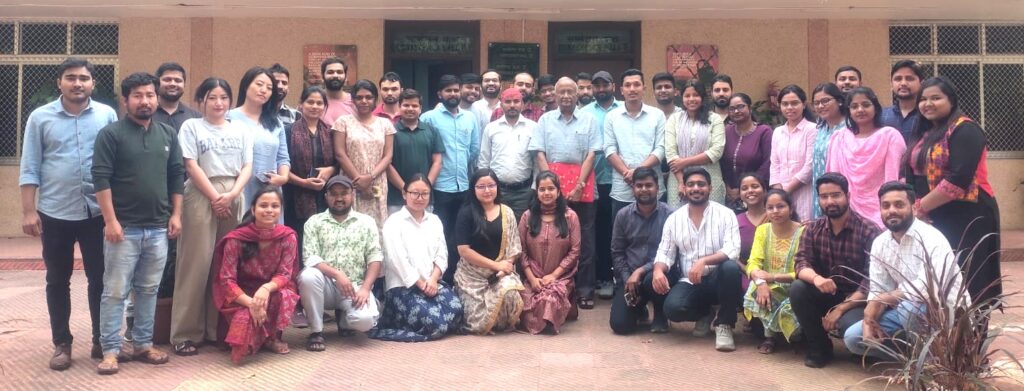
The NIC and Ministry of Panchayati Raj officials briefed about the e-Panchayat. The sessions encompassed various facets of Panchayati Raj, including the functions of Gram Panchayats and principles of good governance. Extensive discussions were held on different flagship schemes and the nine LSDG themes. The participants were divided into nine groups, and they participated in a group exercise focusing on resource allocation, activity mapping, and the creation of sample GPDPs enabled by PDI for LSDG-based themes. On the last day, presentations were made on the actionable points within the Project GPs. During the sessions, strategies for achieving project outcomes through high-impact actions were brainstormed and deliberated upon. The experts from CPRDP & SSD and NIRDPR faculty, senior consultants, and guest faculties shared their expertise as subject matter specialists and practitioners.
The training concluded with assessments and feedback sessions, ensuring participants’ understanding and providing a platform for continuous improvement. Participants were prepared to work in mission mode with dedication and commitment towards project goals. The programme was evaluated on a five-point scale by the YFs, who rated it as excellent. The YFs expressed their utmost satisfaction with the facilities provided to them during their stay on the NIRDPR Campus.
Dr Anjan Kumar Bhanja, Associate Professor and Head of CPRDP&SSD, NIRDPR, was the Director of the Induction Level Orientation Programme.
The program was structured with group activities, sessions with expert faculties, and field visits, which enlightened me on theory, practical realities, and approaches to be taken on the ground with communities.
Mr. Abhishek Kumar, Young Fellow (Bihar)
The training session on the important portals and apps of the MoPR facilitated by the Consultants from the MoPR and NIC was informative, especially the segment on how to formulate a Sankalp (LSDG theme-wise) and develop a comprehensive thematic GPDP. It provided us with a roadmap, setting ambitious yet achievable goals and devising strategies to accomplish them efficiently.
-Ms. Mani Mardi, Young Fellow (Jharkhand)
